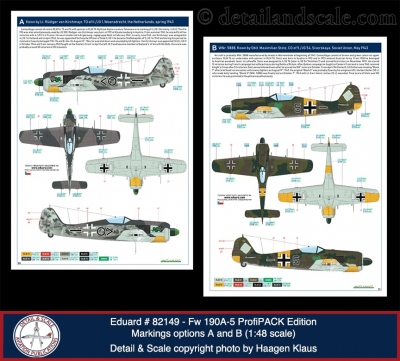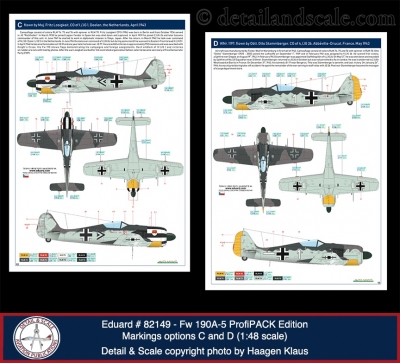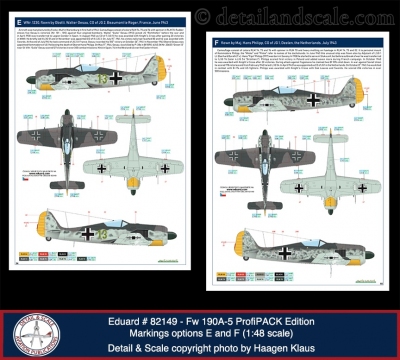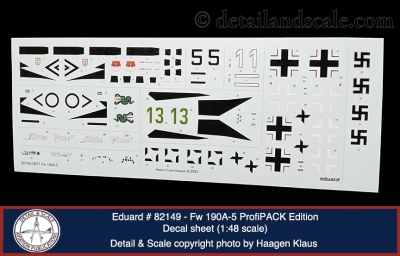Eduard # 82149 Fw 190A-5 Light Fighter ProfiPACK Edition
— 1:48 Scale
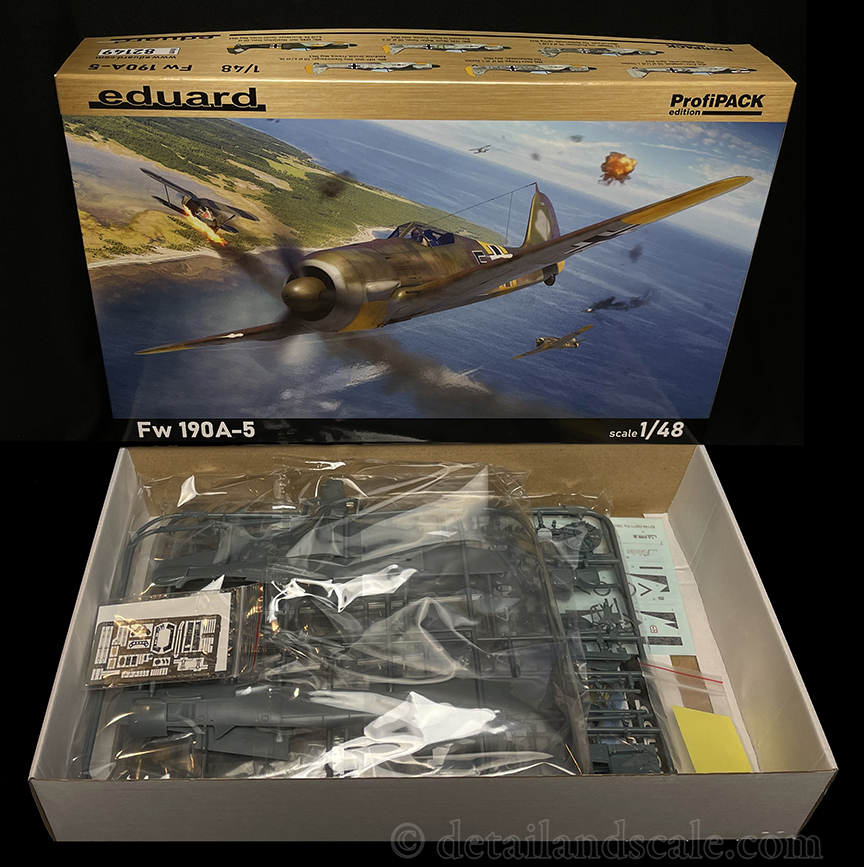
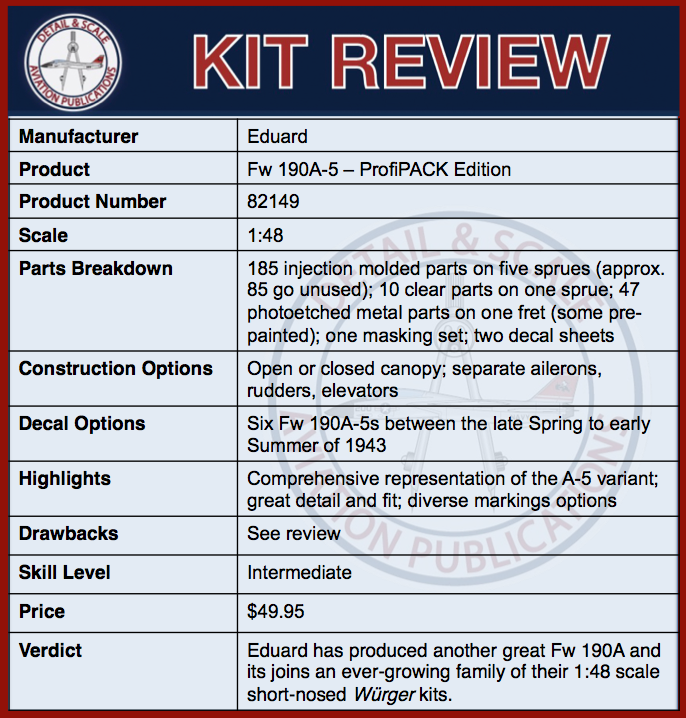
The Fw 190 was one of the best-known aircraft of the 20th century. Eduard’s family of new-tool Fw 190As in 1:48 scale has made a big impression among scale modelers since they started rolling out in 2017. In this review, we take a look at their latest issue of the Fw 190A-5 in a ProfiPACK edition boxing

In 1934, the German Ministry of Aviation (RLM) issued a call for proposals for a modern fighter design to definitively rearm and modernize the Luftwaffe. The Bf 109 was selected in 1936, but by 1937, the RLM saw a need for a second fighter to complement the Bf 109. Focke-Wulf designers, led by Kurt Tank, took another look at their losing Fw 159 prototype. The design reached maturity with inclusion of an air-cooled, 14-cylinder BMW 139 radial engine, a low-drag cowling and other aerodynamic improvements, and extensive use of electrically-actuated control surfaces (versus a hydraulic system) that made handling more crisp and responsive.
The first of nearly 20,000 Fw 190 Würgers (or Shrikes) flew on 01 June 1939. The Fw 190 was arguably the Luftwaffe’s most effective day fighter, serving in every corner of Europe and North Africa. It also excelled as a fighter-bomber, dedicated ground-attack platform, and night fighter. In the opinion of many pilots, the Fw 190 was superior to the Bf 109 in terms of armament and low to mid-altitude performance.
The Fw 190A-5 was a slightly upgraded Fw 190A-4. The A-4 itself was an improved A-3, armed with the standard pair of 7.9mm MG 17 machine guns above and behind the engine and two MG 151 20mm cannons in the wing roots. The A-5 capitalized on the extra power from the BMW 801D-2 engine to carry more air-to-ground ordinance. The powerplant was also equipped with a power boost system. To facilitate this, the nose was stretched a mere six inches, and this extension carried through to Fw 190A-9 production. Yet, the small stretch was sufficient to shift the center of gravity to accommodate drop tanks and a 550-pound bomb on a centerline bomb rack. Outboard cannons were deleted to save weight in many A-5s. Seventeen A-5 subvariants were eventually produced. The full run amounted to nearly 1,800 A-5 airframes between November 1942 and June 1943.

Eduard’s ProfiPack edition of their Fw 190A-5 comes in a standard top-opening box. Five blue-gray sprues hold a total of 185 parts (about 100 will be used; see below). Ten clear parts are on also found on one sprue. As a ProfiPACK edition, there’s also one fret of pre-painted photoetched metal parts containing 47 parts and one pre-cut masking set for the masking of the clear parts and wheel hubs. The full-color instruction booklet guides the build over nine pages. The decal sheets provide full airframe stencils and markings for six airplanes:
- Fw 190A-5, flown by Lt. Rüdiger von Kirchmayr, TO of II./JG 1, Woensdrecht, the Netherlands, Spring 1943
- Fw 190A-5 W. Nr. 5888, flown by Oblt. Maximilian Stotz, CO of /JG 54, Siverskaya, Soviet Union, May 1943
- Fw 190A-5, flown by Maj. Fritz Losigkeit, CO of I./JG 1, Deleen, the Netherlands, April 1943
- Fw 190A-5 W. Nr. 1197, flown by Oblt. Otto Stammberger, CO of /JG 26, Abbeville-Drrucat, France, May 1943
- Fw 190A-5 W. Nr. 1230, flown by Obstlt. Walter Oesau, CO of JG 2, Beaumont le Roger, France, June 1943
- Fw 190A-5 “Minke Pinke,” flown by Maj. Hans Phillip, CO of JG 1, Deleen, the Netherlands, July 1943
Strengths: Four years after their first new-tool short-nosed Würgers appeared in hobby shops, scale modelers agree: the new tool kits address all previous critiques of Eduard’s first generation 1:48 scale Fw 190A/Fs. Furthermore, these are among the best kits that have been produced by Eduard, and among other accolades, the first kit released in this family won the 2017 Detail & Scale Editor’s Choice Kit of the Year award.
All of the observations that apply to Eduard’s previous new-issue Fw 190s apply here. Of course, one of the big questions is how Eduard did with their A-5 configuration. The longer A-5 nose added about six inches to the airframe, and that translates to an additional 3.1mm in 1:48 scale. Measured by my digital calipers, the fuselage halves on the new Sprue R is exactly 3.1mm longer than the Fw 190A-2, A-3, and A-4 produced by Eduard. The new wings on Sprue G are also retooled so as only to have the inboard MG 151 cannons fitted. Again, this is correct for most Fw 190A-5s. Still, check your references, because there were multiple different configurations of outer wing gun presence/absence depending on what A-5 subvariant is involved.
The parts breakdown and overall engineering result in a kit that is quite straightforward and easy to build. Construction will not be particularly time consuming. Surface detail is outstanding as expected from Eduard, with beautifully executed and restrained recessed panel lines and elegant recessed rivet details arrayed into complex and accurate patterns. I snipped out the fuselage halves and wings to dry fit them, and they appear to line up in airtight fashion. No filler required.
The plastic cockpit parts by themselves are a bit simplified, but the 47 pre-painted photoetched metal parts for the instrument panel, side consoles, shoulder harnesses, and lap belts (among other detail parts) add a vital impressive level of detail (as it would seem Eduard always intends). Engine exhaust stacks are okay for 1:48 scale, while the exhausts themselves are not hollow as a resin casting can achieve (and there’s a Brassin set for that; see below). Still, the kit parts do feature slightly recessed faces, and a good wash of a dark color can achieve the illusion of a deeper exhaust.
The landing gear, tires, and tailwheel assembly are all very nicely detailed and molded. The rudder, elevators, and ailerons are all separate parts. At least for the rudder, the mounting tab forces a straight-in fit, and a little modification might be necessary to place the rudder in a deflected position. The clear parts are gorgeous and possess perfect optical quality with no seams present. Likewise, the pre-painted photoetched parts are beautifully made and appear just about perfect.
There are a lot of unused parts in this kit – about 85 or so in all. These include an additional propeller, other MG 17 fairings, underwing, dipole night fighter antennas, and alternate gear doors, rudders, and ailerons for other Fw 190 variants.
The decal sheets are printed in-house by Eduard and cover the six well-chosen and eye-catching schemes described above. There’s also a complete set of airframe stencils. Alternate decal versions of the instrument faces are also provided if working with the PE parts is not the builder’s preference. Printing appears perfect. Everything is in register, colors look great, and carrier film is finely restrained. Note that the decals are of the wet-transfer type and are applied differently than water-slide decals.
Weaknesses: There’s very little to critique here. First, the landing flaps are not molded as separate parts, but there’s an Eduard PE set for that. Second, I do believe the inboard main gear well doors should be closed when the airplane is parked. They cycled open and then closed when the gear was either retracted or extended. Third, the cockpit and gear wells are just a bit simplified. I can confirm this as I had my head up in the gear wells of a pair of 190s during my last trip to the Military Aircraft Museum in Virginia Beach, Virginia. Again, there’s plenty of photoetched and Brassin sets to take care of any “soft” detail there, and almost anyone can add the appropriate wiring/plumbing in the wells with very little effort. At the end of the day, these three points do not represented substantive critiques but things to think about as you plan your build.

Overall, this is another excellent 1:48 scale kit of the Fw 190. Its quality, detail, and interesting paint schemes hit on all the right points to pique the interest of many scale modelers. For those interested in adding even more features to the Eduard Fw 190A-5, Eduard has released a wide range of released cockpit, engine, machine gun, and cannon bay detail sets to cater to practically any and every extra level of detail one might desire.
Sincere thanks to Eduard for the review sample. You can visit them on the web at http://www.eduard.com and on Facebook at https://www.facebook.com/EduardCompany
Haagen Klaus
Scale Modeling News & Reviews Editor
Detail & Scale


